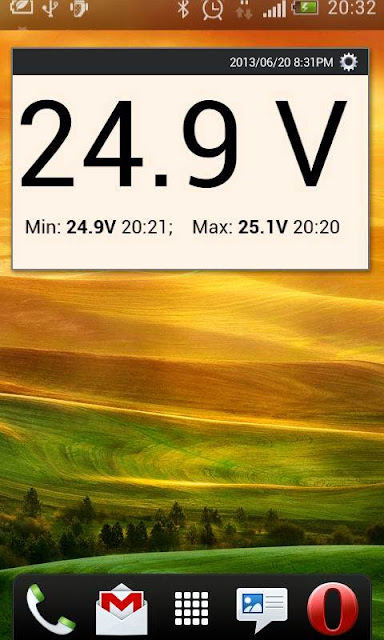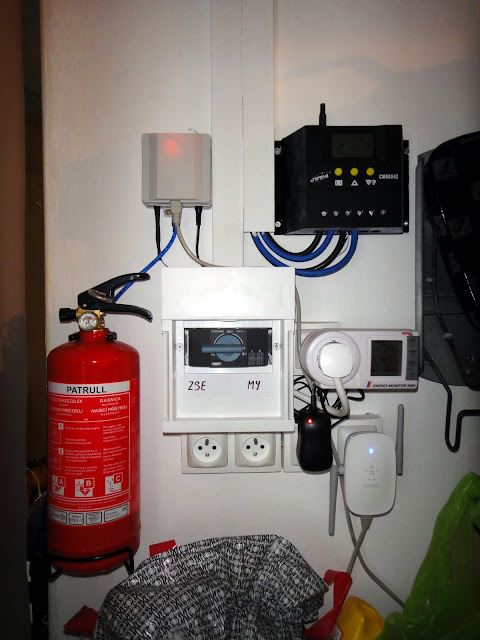Arduino monitoring pre smartphony
- ixo
- Příspěvky: 489
- Registrován: stř říj 10, 2012 6:11 pm
- Reputace: 23
- Bydliště: Bratislava
Arduino monitoring pre smartphony
Ahojte,
tymto sa pridavam k bastlicom v Arduine a s radostou vam ponukam svoje minidielko. Umožňuje zobrazovať v smartphone aktualne napatie baterii a zaznamenane minimalne a maximalne napatie v ramci dna, aj s uvedenim casu. Cas sa natiahne z NTP servera pri starte arduina. Realizacia celeho riesenia vyzera v telefone takto:

Samotna Android appka, ktora zabezpecuje zobrazenie HTML arduinom generovanej stranky v automaticky refreshovanom widgete sa da stiahnut tu:
https://play.google.com/store/apps/deta ... S53ZzAxIl0.
Tu je arduino kod:
V kode je na prepocet hodnot z A/D prevodnika pouzita konstanta 0.03193172626682720, bude potrebne si ju upravit v zavislosti od konfiguracie vasho napatoveho delica. Napatie mi prepocitava bud presne na desatinu volta, pripadne o jednu desatinu volta viac (len preto, ze som nemal presny multimeter pri vypocte konstanty). S kodom si samozrejme robte, co len chcete, za pripadne skody samozrejme nerucim. 
A treba mat samozrejme od internet providera verejnu IP a know-how, ako si ju preroutovat na IP arduina. Komu sa casto meni verejna IP, moze si zriadit ucet na no-ip.com a pristupovat k arduinu cez domenovy nazov, napriklad (nejakynazov.no-ip.info).
Este fotka nasho hi-tech satnika:

Zlava hore doprava dole:
Skatulka, v ktorej je skryte Arduino. Ma vetracie otvory, vobec sa neprehrieva. Hrubsi cierny kabel v sebe skryva napatovy delic;
PWM regulator;
Hasiaci pristroj;
Mechanicky prepinac siete;
Elektromer solarneho okruhu;
Zasuvka "silna" - vzdy je v nej prud z verejnej siete;
Zasuvka prepinana - bud prepnuta verejna siet, alebo solarna;
Napajanie arduina;
WiFi repeater - don je kablom pripojene Arduino.
tymto sa pridavam k bastlicom v Arduine a s radostou vam ponukam svoje minidielko. Umožňuje zobrazovať v smartphone aktualne napatie baterii a zaznamenane minimalne a maximalne napatie v ramci dna, aj s uvedenim casu. Cas sa natiahne z NTP servera pri starte arduina. Realizacia celeho riesenia vyzera v telefone takto:

Samotna Android appka, ktora zabezpecuje zobrazenie HTML arduinom generovanej stranky v automaticky refreshovanom widgete sa da stiahnut tu:
https://play.google.com/store/apps/deta ... S53ZzAxIl0.
Tu je arduino kod:
Kód: Vybrat vše
#include <Time.h>
#include <Ethernet.h>
#include <EthernetUdp.h>
#include <SPI.h>
//TCP/IP konfiguracia
byte mac[] = { 0xDE, 0xAD, 0xBE, 0xEF, 0xFE, 0xED };
IPAddress ip(192,168,2,177);
EthernetServer server(80);
EthernetClient client02;
// NTP konfiguracia
IPAddress timeServer(132, 163, 4, 101); // time-a.timefreq.bldrdoc.gov
const int timeZone = 2;
EthernetUDP Udp;
unsigned int localPort = 8888; // local port to listen for UDP packets
const int NTP_PACKET_SIZE = 48; // NTP time is in the first 48 bytes of message
byte packetBuffer[NTP_PACKET_SIZE]; //buffer to hold incoming & outgoing packets
// Premenne widgetu
float maximum = 0;
int max_hod;
int max_min;
float minimum = 100;
int min_hod;
int min_min;
int den = 0;
float napatie;
// Setup
void setup() {
Serial.begin(9600);
Ethernet.begin(mac, ip);
server.begin();
Udp.begin(localPort);
setSyncProvider(getNtpTime);
}
//A rob dokola
void loop() {
EthernetClient client = server.available();
if (client) {
// Serial.println("Novy klient");
boolean currentLineIsBlank = true;
while (client.connected()) {
if (client.available()) {
char c = client.read();
if (c == '\n' && currentLineIsBlank) {
client.println("HTTP/1.1 200 OK");
client.println("Content-Type: text/html");
client.println("Connection: close");
client.println();
client.println("<!DOCTYPE HTML>");
client.println("<html>");
client.println("<head>");
client.println("</head>");
client.println("<body style='background-color:#FFEBD7;'>");
int scitavane = 0;
for (int a = 1; a<=20; a++) {
int sensorReading = analogRead(3);
delay(100);
scitavane = scitavane + sensorReading;
}
client.print("<div><span style='font:100px arial,sans-serif;'>");
float napatie = (float)(round((((float)scitavane/(float)20)) * (float)0.03193172626682720 * (float)10)/(float)10);
client.println((float)napatie,1);
client.println("V</span>");
// Ak je aktualne cislo mensie ako minimum, updatni minimum
if ((float)napatie < (float)minimum) {
minimum = (float)napatie;
min_hod = (int)hour();
min_min = (int)minute();
Serial.print("Preniesol som nacitane: ");
Serial.println(min_min);
}
// Ak je aktualne cislo vacsie ako maximum, updatni maximum
if ((float)napatie > (float)maximum) {
maximum = (float)napatie;
max_hod = (int)hour();
max_min = (int)minute();
}
client.print("<br>");
client.print("<span style='font:16px arial,sans-serif; width:200px;padding-left:10px;'>");
client.println("Min: <b>");
client.print(minimum,1); client.print("V</b> ");
client.print((min_hod));client.print(":");
if (min_min < 10) {client.print("0");}
client.print((min_min));
client.print("; ");
client.println("Max: <b>");
client.print(maximum,1);client.print("V</b> ");
client.print(max_hod);client.print(":");
if (max_min < 10) {client.print("0");}
client.print(max_min);
client.println("</span></div>");
// Ak sa zmenilo cislo dna, nuluj
if ((int)den != (int)day()) {
minimum = 100;
maximum = 0;
den = (int)day();
}
client.println("</body>");
client.println("</html>");
break;
}
if (c == '\n') {
currentLineIsBlank = true;
}
else if (c != '\r') {
currentLineIsBlank = false;
}
}
}
// Dajme browseru trochu casu
delay(1);
client.stop();
// Serial.println("client disonnected");
}
}
time_t getNtpTime()
{
while (Udp.parsePacket() > 0) ; // discard any previously received packets
Serial.println("Transmit NTP Request");
sendNTPpacket(timeServer);
uint32_t beginWait = millis();
while (millis() - beginWait < 1500) {
int size = Udp.parsePacket();
if (size >= NTP_PACKET_SIZE) {
Serial.println("Receive NTP Response");
Udp.read(packetBuffer, NTP_PACKET_SIZE); // read packet into the buffer
unsigned long secsSince1900;
// convert four bytes starting at location 40 to a long integer
secsSince1900 = (unsigned long)packetBuffer[40] << 24;
secsSince1900 |= (unsigned long)packetBuffer[41] << 16;
secsSince1900 |= (unsigned long)packetBuffer[42] << 8;
secsSince1900 |= (unsigned long)packetBuffer[43];
return secsSince1900 - 2208988800UL + timeZone * SECS_PER_HOUR;
}
}
Serial.println("No NTP Response :-(");
return 0; // return 0 if unable to get the time
}
// send an NTP request to the time server at the given address
void sendNTPpacket(IPAddress &address)
{
// set all bytes in the buffer to 0
memset(packetBuffer, 0, NTP_PACKET_SIZE);
// Initialize values needed to form NTP request
// (see URL above for details on the packets)
packetBuffer[0] = 0b11100011; // LI, Version, Mode
packetBuffer[1] = 0; // Stratum, or type of clock
packetBuffer[2] = 6; // Polling Interval
packetBuffer[3] = 0xEC; // Peer Clock Precision
// 8 bytes of zero for Root Delay & Root Dispersion
packetBuffer[12] = 49;
packetBuffer[13] = 0x4E;
packetBuffer[14] = 49;
packetBuffer[15] = 52;
// all NTP fields have been given values, now
// you can send a packet requesting a timestamp:
Udp.beginPacket(address, 123); //NTP requests are to port 123
Udp.write(packetBuffer, NTP_PACKET_SIZE);
Udp.endPacket();
}
A treba mat samozrejme od internet providera verejnu IP a know-how, ako si ju preroutovat na IP arduina. Komu sa casto meni verejna IP, moze si zriadit ucet na no-ip.com a pristupovat k arduinu cez domenovy nazov, napriklad (nejakynazov.no-ip.info).
Este fotka nasho hi-tech satnika:
Zlava hore doprava dole:
Skatulka, v ktorej je skryte Arduino. Ma vetracie otvory, vobec sa neprehrieva. Hrubsi cierny kabel v sebe skryva napatovy delic;
PWM regulator;
Hasiaci pristroj;
Mechanicky prepinac siete;
Elektromer solarneho okruhu;
Zasuvka "silna" - vzdy je v nej prud z verejnej siete;
Zasuvka prepinana - bud prepnuta verejna siet, alebo solarna;
Napajanie arduina;
WiFi repeater - don je kablom pripojene Arduino.
1900 Wp, LiFePo 8x200Ah + 123\SmartBMS, Tristar MPPT 60A, Meanwell 1 kW, PowerJack 5kW, Bratislava
Monitoring systému: https://panel.homeinfo.sk/?id_objekt=15 ... elektraren
(Ne)návratnosť systému: https://tinyurl.com/cx74hkv
Zdieľaná databáza meničov: https://tinyurl.com/mx6gvsj
Monitoring systému: https://panel.homeinfo.sk/?id_objekt=15 ... elektraren
(Ne)návratnosť systému: https://tinyurl.com/cx74hkv
Zdieľaná databáza meničov: https://tinyurl.com/mx6gvsj
-
PavelR
- Příspěvky: 3546
- Registrován: ned led 29, 2012 3:59 pm
- Reputace: 265
- Lokalita: Žabčice
- Systémové napětí: 48V
- Výkon panelů [Wp]: 29139
- Kapacita baterie [kWh]: 65
- Chci prodávat energii: ANO
- Chci/Mám dotaci: NE
Re: Arduino monitoring pre smartphony
Tak toto je naprosto fenomenalni....
-
007ToMMaS
- Příspěvky: 1095
- Registrován: sob zář 15, 2012 8:53 pm
- Reputace: 16
Re: Arduino monitoring pre smartphony
Vynikajúce. Vidím v tom využitie a uplatnenie keď sa raz pustím do urobenia akejsi stanice o informácii o mojej FVE. Kde sa budú zobrazovať data na displej, mobile, a možno aj na webe. Dúfam to bude čoskoro. Teraz riešim bezdrátový prenos pomocou 433mhz a arduina mini. Len akosi keď to zavriem v rozvádzači tak signál je fuč. Jedno arduino mega bude akási ústredňa a arduino mini pro(tých bude asi aj viac) bude odosielať na megu.
3,2kWp REC320NP - juh
3,6kWp - Phonosolar PS450M5GFH-24/TH- východ
2x IGridSV-IV5.6KW, 2x Li-ion - 48V / 156Ah =312Ah
3,6kWp - Phonosolar PS450M5GFH-24/TH- východ
2x IGridSV-IV5.6KW, 2x Li-ion - 48V / 156Ah =312Ah
-
střídač
- Příspěvky: 544
- Registrován: stř led 02, 2013 4:28 pm
- Reputace: 17
Re: Arduino monitoring pre smartphony
Vypadá to tak, že "Faradayova klec" a tím i fyzikální zákony, vskutku fungují.007ToMMaS píše:Len akosi keď to zavriem v rozvádzači tak signál je fuč
-
007ToMMaS
- Příspěvky: 1095
- Registrován: sob zář 15, 2012 8:53 pm
- Reputace: 16
Re: Arduino monitoring pre smartphony
Tak tak. Čo človek zavre do plechového rozvádzača a potrebuje to signál tak je to nereálne. Problém vyviesť nejakú anténku von neni problém .
3,2kWp REC320NP - juh
3,6kWp - Phonosolar PS450M5GFH-24/TH- východ
2x IGridSV-IV5.6KW, 2x Li-ion - 48V / 156Ah =312Ah
3,6kWp - Phonosolar PS450M5GFH-24/TH- východ
2x IGridSV-IV5.6KW, 2x Li-ion - 48V / 156Ah =312Ah
-
PavelR
- Příspěvky: 3546
- Registrován: ned led 29, 2012 3:59 pm
- Reputace: 265
- Lokalita: Žabčice
- Systémové napětí: 48V
- Výkon panelů [Wp]: 29139
- Kapacita baterie [kWh]: 65
- Chci prodávat energii: ANO
- Chci/Mám dotaci: NE
Re: Arduino monitoring pre smartphony
Zdravim.
Nevite nekdo kde by sly stahnout ty soubory time.h a ethernetudp.h ? Nejak se mi nedari najit funkcni download ....
Nevite nekdo kde by sly stahnout ty soubory time.h a ethernetudp.h ? Nejak se mi nedari najit funkcni download ....
- Frenky
- Příspěvky: 870
- Registrován: pon led 21, 2013 6:36 pm
- Reputace: 149
- Lokalita: Doubravička
- Systémové napětí: 48V
- Výkon panelů [Wp]: 8700
- Kapacita baterie [kWh]: 25
- Chci prodávat energii: NE
- Chci/Mám dotaci: NE
- Bydliště: Doubravička
Re: Arduino monitoring pre smartphony
24x Solární panel JINKO SOLAR 225 Pmpp=225W, 2x Regulátor STUDER VT-80, 2x Střídač Studer XTM 4000-48, BSP, RCC, 1x AKU 48V LFP200Ah 1x AKU 48 V LFP280Ah. Řizení a dohled, SDS, vlastní vyčítání arduinem DUE v krabičce (ARMOSY), export dat do RPi s databází a html stránkou.
http://95.85.214.80, viewtopic.php?t=4809
http://95.85.214.80, viewtopic.php?t=4809
-
PavelR
- Příspěvky: 3546
- Registrován: ned led 29, 2012 3:59 pm
- Reputace: 265
- Lokalita: Žabčice
- Systémové napětí: 48V
- Výkon panelů [Wp]: 29139
- Kapacita baterie [kWh]: 65
- Chci prodávat energii: ANO
- Chci/Mám dotaci: NE
-
PavelR
- Příspěvky: 3546
- Registrován: ned led 29, 2012 3:59 pm
- Reputace: 265
- Lokalita: Žabčice
- Systémové napětí: 48V
- Výkon panelů [Wp]: 29139
- Kapacita baterie [kWh]: 65
- Chci prodávat energii: ANO
- Chci/Mám dotaci: NE
Re: Arduino monitoring pre smartphony
Zkousel to nekdo? funguje vam to nastaveni casu?
me to porad pise toto
Transmit NTP Request
No NTP Response
me to porad pise toto
Transmit NTP Request
No NTP Response
-
Solarnoob
- Příspěvky: 133
- Registrován: pát dub 29, 2022 9:35 am
- Reputace: 10
- Lokalita: Kadaň
- Systémové napětí: 48V
- Výkon panelů [Wp]: 1680
Re: Arduino monitoring pre smartphony
Pokud někdo používá "Mobilní internet" LTE od operátorů a funguje mu to, at mi rekne jak na to. Mě to u Vodafonu nefungujeixo píše:Komu sa casto meni verejna IP, moze si zriadit ucet na no-ip.com a pristupovat k arduinu cez domenovy nazov, napriklad (nejakynazov.no-ip.info).
9x 280 Wp AmeriSolar| Axpert King I 5000-48V | 4x Sonnenschein SRP 12V 175 A RAIL
-
soami
- Příspěvky: 1031
- Registrován: pon lis 08, 2021 9:10 pm
- Reputace: 102
- Lokalita: Posázaví
- Systémové napětí: 48V
- Chci prodávat energii: NE
- Chci/Mám dotaci: NE
- Bydliště: Posázaví
Re: Arduino monitoring pre smartphony
Na to bys potřeboval veřejnou IP nebo vlastní VPN. Teď jsi za NAT operátora, což je na druhou stranu i trochu výhoda v bezpečnosti.
Kdo je online
Uživatelé prohlížející si toto fórum: Claudebot [Bot] a 1 host

